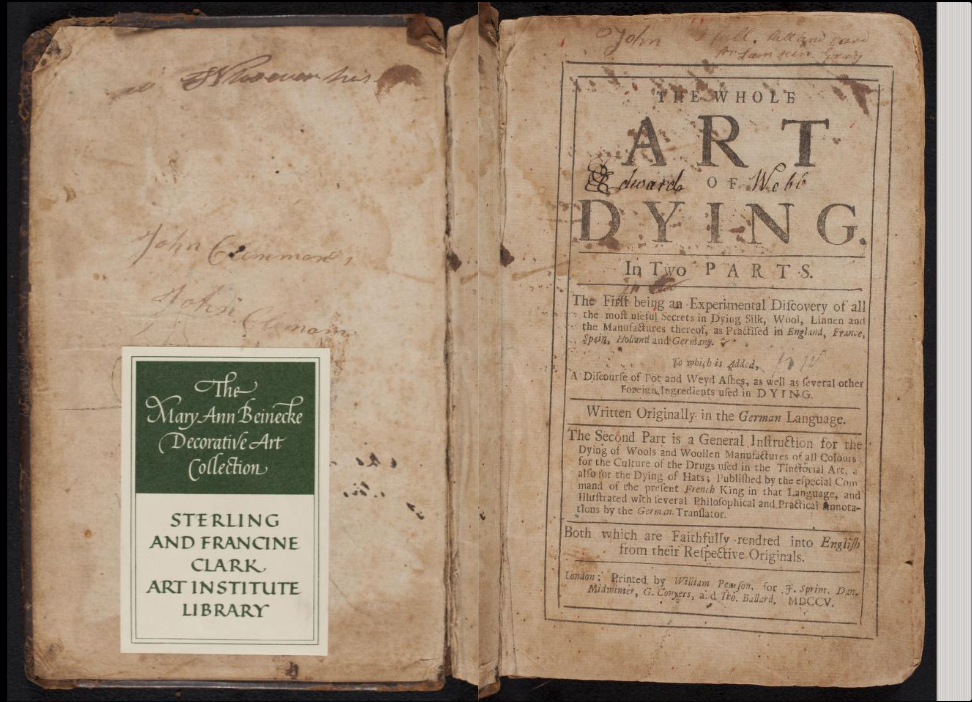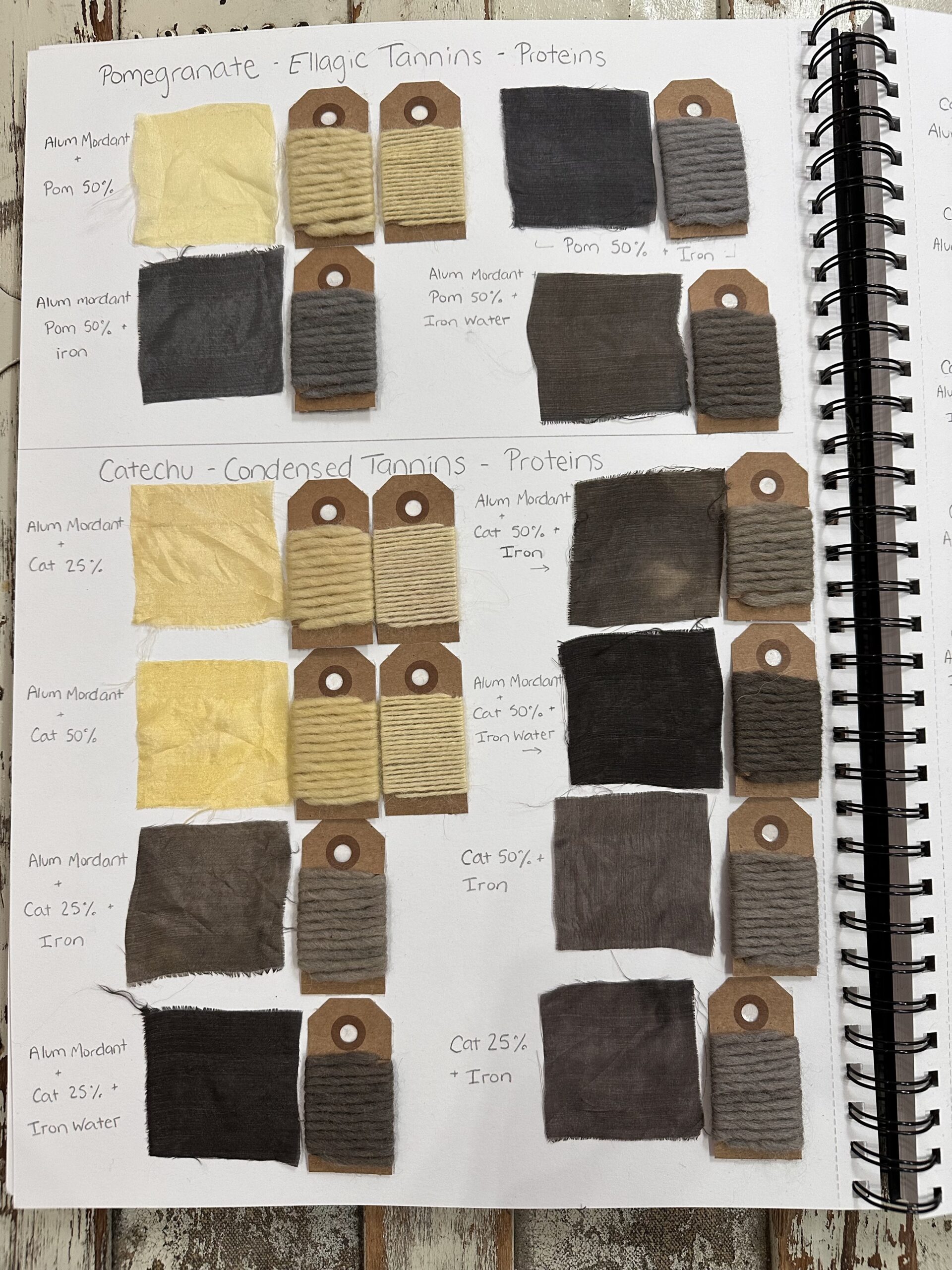The use of dying not dyeing is not mine, just to be clear!
I’ve very recently discovered this book and am currently completely fascinated by it, even though it was printed out of my period of interest, in 1705 in London. The full title text includes:
“The whole art of dying : in two parts, the first being an experimental discovery of all the most useful secrets in dying silk, wool, linnen and the Manufactures thereof, as Practised in England, France, Spain, Holland and Germany. To which is Added, A Discourse of Pot and Weyd Ashes, as well as several other Foreign Ingredients used in DYING. Written Originally in the German Language: the second part is a general instruction for the dying of wools and woollen manufactures of all colours”
Having read some of it I can see some influences from earlier sources and a clear amount of learning from what are, to be fair, practices that can’t really have changed all that much in terms of mordanting and scouring and the use of period ingredients being used, trialed, mixed and so on. I believe it is fair then to include this book as of interest to medieval dyers as a round up of lessons learned in the past and how they were being taken into the future. There was also a great amount of secrecy that originally surrounded the dyeing trade secrets which was only really starting to lift by the end of our period of interest. This work is a translation of works from Germany and France, primarily, which sets those original texts at an earlier time, and those works are likely to have been also extensions of earlier works as well.

(from https://archive.org/details/MAB31962000742134Images/page/n1/mode/2up)
On top of this it’s just a fascinating document historically. Let me pull out some interesting bits from the text addressed to the reader:
- The English voice and concerns that introduce these translations, for example
“And indeed there is no shadow of Reason why what is really found to be the Interest of that Nation [France] in this particular; should not be unquestionably determin’d to be ours; since our Soil is at least as capable of producing any of the mentioned necessary Drugs, and if not more temperate, is still more particularly appropriated to the Culture of most of ’em than the so much boasted FRANCE. And if I am not mistaken, those Enemies of the ENGLISH Nation, who as maliciously as unjustly have deprived us of the Talent of Invention, have never yet presumed to dispute with us that of Improvement, even in a Degree very much exalted above that of our Neighbours. And as there are numerous Inventions, too tedious to be recited here, which a short Retrospection gives us a right to lay claim to: So the particular Improvements which our ENGLISH Manual Artists only have made to the Arts of Weaving, Glass-making, Iron, Steel, and all sorts of Metallick Works, Cabinet- making, Naval Architecture, Watch-making, &c. are so Prodigious, that the Traveller who only takes a view of the most finished pieces of all other Nations, (not excepting even those to whom we owe the Arts themselves) if he judges impartially must really be surprized to find them such clumsy indigested Lumps as they appear, when compared with the performances of our meanest Artists : It is this which hath at once raised the Envy, and occasioned the fraudulent practices of other Nations; who by repeated vain essayes finding themselves unable to equal us, are resolved to revenge their pretended injury by basest deceit : Hence it is that not only the Watch-makers of GENEVA, but those of FRANCE as well as other Countries, make bold with the Celebrated Names of TOMPION and QUARE to put off their worthless Performances at a high Rate, which if no better paid for than they deserve, would for ever remain in the Hands of their Makers. Nor is this the only particular in which the ENGLISH Artist is injured abroad: For throughout EUROPE the best Manufacturers which the shopkeeper can show are either ENGLISH, or such as are made in Imitation of them, and Knavishly sold as such to the great prejudice of the Ignorant Buyer.”
So there.
That aside it is a wonderful capture of how Europe was perceived in terms of the great dyeing centres :
“The first originally Written in the GERMAN Language is the Result of the long experience of the best Masters of the Tinctorial Art at FRANKFORT, NURENBERG, LEIPZIG, ERFURT, HAMBURG, GENEVA and the Low Countries”
He goes on to say the book should ” enable the Intelligent Master of it to discover why the SPANISH, DUTCH, or any other Nation should be famed for Dying any particular Colour better than our own [English]”
2. Those who know me also know I have a great interest in glasswork, and have long since extolled the virtues of Italy as a source of great dyes AND great glass, so I was particularly amused to come across “VENICE which not many Ages since was very Famous for supplying all Parts not only of EUROPE but of the whole World with its then unparallell’d Glass, is now content to buy it of ENGLAND. And whoever of late years pretends to the making of all Optical Glasses and Mathematical Instruments, it is out of Dispute amongst judges in what Country the best are to be found.”
3. The wonderful use of words like “stuffs” which sounds right and proper to me, and “The art of using the druggs to the best advantage in dying”, which just sounds so weird in this day and age. This is an example of what is meant by drugg though
“THE Blew Dye is prepared from the best Woad called Pastel, which grows in the upper LANGUEDOC, and is the best and most necessary Drug in the Art of Dying; with VOUEDE, which is a sort of Woad, that’s weaker and less substantial, and grows in NORMANDIE; and with Indigo which comes from the INDIES; which (tho’ used alone is none of the best Colours yet,) never misses of success, if you do not mix above the quantity of Six Pound, with every Bail of Woad, and if it be not used before it is prepared in Copper and in the two first heatings.”
4. The names of the ingredients and where they come from.. I just love it. Brasjl Wood, Orseille (a lichen dye) and statements like “There seven sorts of good Reds, which make four mixtures in the Composition of other Colours. The first is the Scarlet, called the Gobelins or FRENCH Scarlate; the Second Crimson; the Third Madder Red, or ROUGE DE GARANCE; the Fourth, half Scarlate ROUGE DE DEMY grain; the Fifth half Crimson; Sixth ROUGE DE NACARAT DE BOURRE, or Scarlate Shred Dye, a Colour somewhat paler than Orange, enclining to Crimson; The Seventh, The DUTCH Cochineal Scarlate. These seven sorts of good Red, may be reduced to three from the three principal Drugs which gives them the Dye, namely the Kermes Berries, Cochineal and Madder; but this division nor being so proper for the mixtures, or Composition of Colours, we shall rather make Use of the former.”
If you want to take a look, images of all the pages of the book are available at the link above and then there is an online transcription available at this amazing site: http://www.elizabethancostume.net/dyes/artdye2.html#part2 which has several dye and colour resources as well as a very great deal of information about Tudor and Elizabethan costume and materials manufacture generally. I will be returning to specific bits of this book in future posts, but just wanted to share that much with you at least!

Leave a Reply